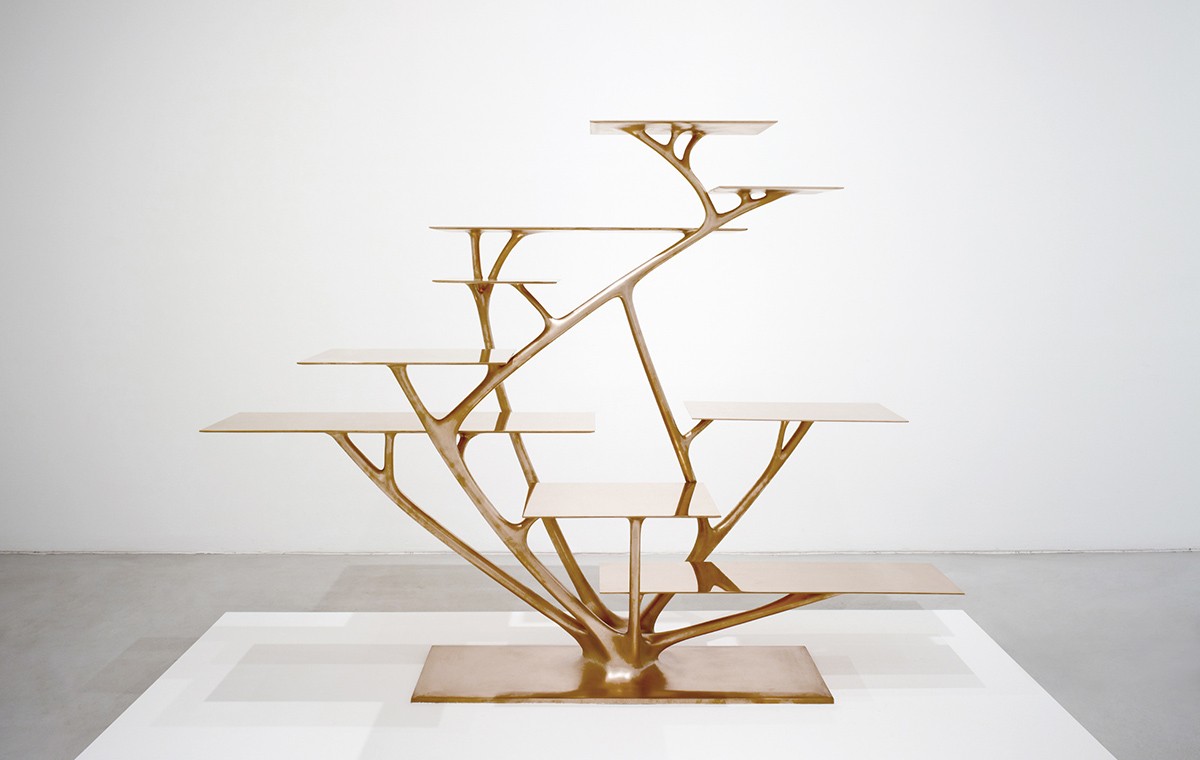At the Museum of Fine Arts, Houston's media preview for "Joris Laarman Lab: Design in the Digital Age," it felt as if I was witnessing "one giant leap" for mankind's art. While we're all struggling trying to 3-D print Thor's hammer, this team has clearly mastered the tools of tomorrow.
Just as my grandfather typeset newspapers by placing backwards metal characters into a tray, and later I set copy first by coding and later on a desktop computer, our children and grandchildren will grow up in a world where 3-D printing is the norm. The 65 objects on view at MFAH represent only 12 years of work and the exhibit is mind-blowing.
Think of the word "algorithm" and we instantly bristle at how Facebook and media outlets use that programming to dictate what we view. Laarman uses algorithms in a completely different way — expanding on early concepts by Dr. Claus Mattheck, a German professor who studied how bones and trees redistribute matter in response to external stimuli — to create his bone series of furniture.
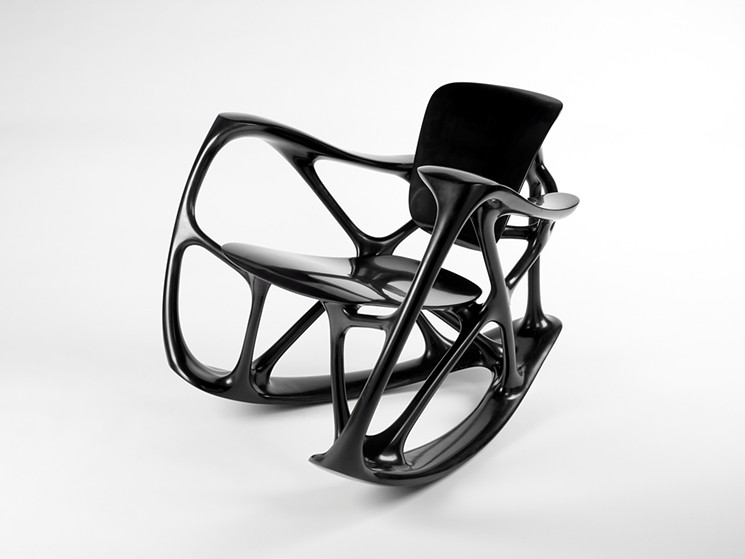
Joris Laarman, produced by Joris Laarman Lab, Bone Rocker, from the collection Bone Furniture, black marble and resin, the Museum of Fine Arts, Houston, Museum purchase funded by the Mary Kathryn Lynch Kurtz Charitable Lead Trust.
© Photo by Joris Laarman
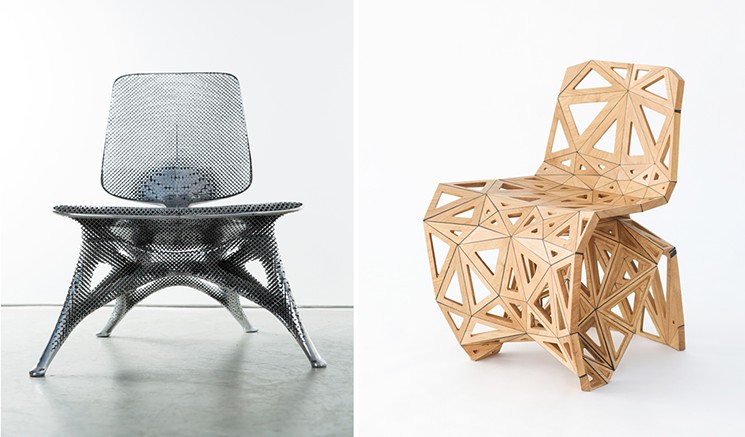
(L) Joris Laarman, produced by Joris Laarman Lab, Aluminum Gradient Chair from the series Microstructures and (R) Joris Laarman, produced by Joris Laarman Lab, Makerchair (Polygon), 2014, oak, courtesy of Joris Laarman Lab.
© Photos by Joris Laarman
The Lab's spinoff company, MX3D, programs robots to draw 3-D objects in the air with molten metal. They're close to completion on a 3-D printed steel bridge being constructed in Amsterdam. Star's video takes us through the process: four robots, 12.5 meters long, six months of printing, 4.500 kilograms of stainless steel and 1100 kilometers of wire. It's a collaboration with experts in the fields of metallurgy, construction, robotics, computing, welding, research and air quality. In addition to the video, viewers can see the Scale model of MX3D Bridge (1:20) as well as other metal objects including a massive acquisition by MFAH titled Dragon Bench.
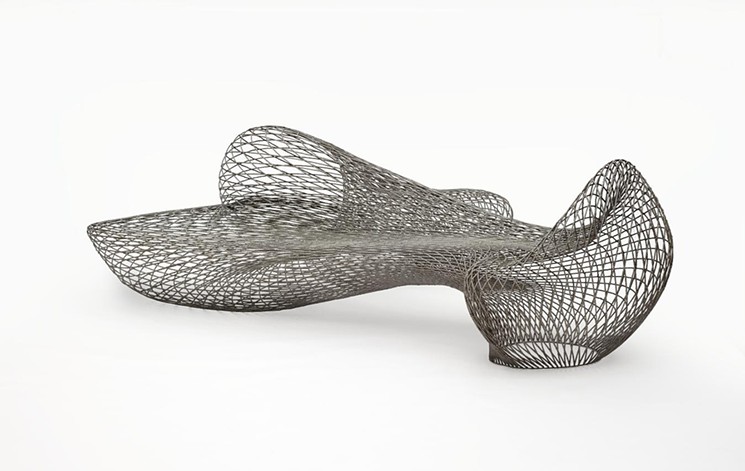
It's much bigger in person. Joris Laarman, produced by Joris Laarman Lab, Dragon Bench, designed 2014, made 2015, the Museum of Fine Arts, Houston, Museum purchase funded by the Caroline Wiess Law Accessions Endowment Fund.
© Photo by Joris Laarman
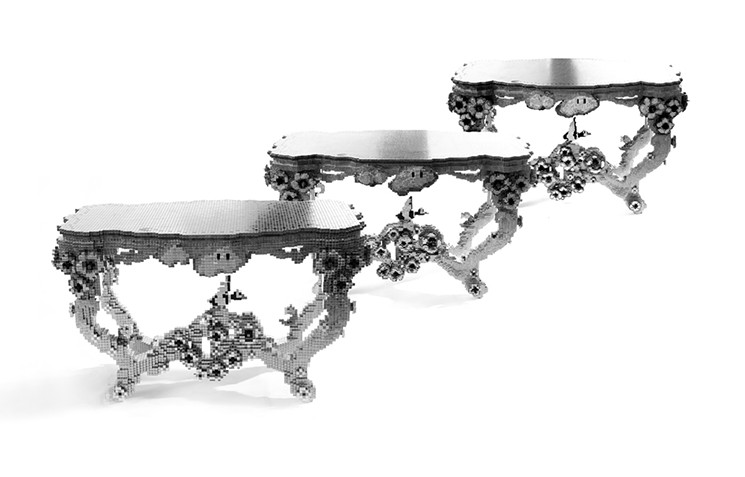
Can you spot the Super Mario and Pac-Man characters? Joris Laarman, produced by Joris Laarman Lab, Kilovoxel, Mega & Giga Voxel Tables, the Groninger Museum, the Netherlands, with support from the Mondrian Fund.
© Photo by Joris Laarman
"Joris Laarman Lab: Design in the Digital Age" opens June 24 and runs through September 16 at the Museum of Fine Arts, Houston, open 10 a.m. to 5 p.m. Tuesdays and Wednesdays, 10 a.m. to 9 p.m. Thursdays, 10 a.m. to 7 p.m. Fridays and Saturdays, 12:15 to 7 p.m. Sundays, Audrey Jones Beck Building, 5601 Main, 713-639-7300, mfah.org, free to $15.
Related programming:
LECTURES & MORE
Members Preview Lecture
Friday, June 22, from 6 to 7 p.m.
Caroline Wiess Law Building / 1001 Bissonnet
Cindi Strauss, the Sara and Bill Morgan Curator of Decorative Arts, Craft, and Design, MFAH, presents an
overview of the exhibition, detailing the highly inventive ways Laarman reimagines traditional forms. This members-only lecture is free. Seating is limited and available on a first-come, first-served basis.
Opening-Day Talk
Sunday, June 24, from 3 to 4 p.m.
Caroline Wiess Law Building / 1001 Bissonnet
On the opening day of Joris Laarman Lab, artist Joris Laarman talks with Cindi Strauss, the Sara and Bill Morgan Curator of Decorative Arts, Craft, and Design, MFAH, about how he challenges the boundaries of art, science, and technology in his work. They also discuss the inspiration he draws from nature and organic forms. Tickets at $10 for nonmembers and $5 for members.
Miniature-Design Workshop: Inspired by “Joris Laarman Lab”
Saturday, June 30, from 2 to 4 p.m.
Audrey Jones Beck Building / 5601 Main Street
Enjoy a presentation about works on view in Joris Laarman Lab followed by an art-making activity led by Glassell School of Art instructor Elena Lopez-Poirot. Participants will create unique miniature interiors and furniture using everyday household items. Tickets are $20 for nonmembers and $10 for members.
ART + DESIGN Community Day
Saturday, July 21, from 11 a.m. to 2 p.m.
The Glassell School of Art / 5101 Montrose Blvd.
Experience an afternoon of live music, games, and art-making activities related to Joris Laarman Lab in the Museum’s Glassell School of Art and on The Brown Foundation, Inc. Plaza. This event is free.
Gallery Concerts
Sunday, July 15, at 2 and 3 p.m.; Performer: Carlos Lopez Jazz Combo
Sundays, July 29 and August 26, at 2 and 3 p.m.; Performer: Craig Hauschildt and friends
Sunday, August 12, at 2 and 3 p.m.; Performer: Nameless Sound
Audrey Jones Beck Building / 5601 Main Street
Enjoy a musical performance inspired by the exhibition. Free with general admission. Camp stools are provided for seating.
Exclusive Tours
Monday, July 2, from 6:30 to 7:30 p.m.; Led by: Marissa Hershon, Curatorial Assistant for Decorative Arts, Craft, and Design
Monday, September 10, from 6:30 to 7:30 p.m.; Led by: Cindi Strauss, the Sara and Bill Morgan Curator of Decorative Arts, Craft, and Design
Audrey Jones Beck Building / 5601 Main Street
Experience a private tour while the museum is closed to the public of Joris Laarman Lab led by one of the exhibition curators. Tickets are $65 and $55 for members.
FAMILY PROGRAMS
Sunday Family Zone
July 1, 8, 15, 22, and 29, from 1 to 4 p.m.
Theme: The Innovation in Art: Discovering Experimental Design
Caroline Wiess Law Building / 1001 Bissonnet
Families are invited to learn about the art on display in Joris Laarman Lab. Drop into the galleries and enjoy a variety of games, activities, looking guides, and books. Each Sunday offers two storybook circles: one at 1:30 p.m. and the second at 3 p.m.
Sunday Family Studio
July 1, from 1 to 2 p.m., and 2:30 to 3:30 p.m.
Theme: Collaboration Station: Exploring Joris Laarman’s Process
July 15, from 1 to 2 p.m., and 2:30 to 3:30 p.m.
Theme: Building Blocks: Exploring the Challenge of Design
Audrey Jones Beck Building / 5601 Main Street
Families can explore art in the studio and create pieces inspired by works on view in Joris Laarman Lab. Registration is required. Adults and infants with their families are free. There is an $8 materials fee to nonmembers and a $6 fee for members.
Our Youngest Artists
August 17 and 18, from 10:30 to 11:15 a.m., and 11:30 a.m. to 12:15 p.m.
Theme: Play with Lines!
Audrey Jones Beck Building / 5601 Main Street
Babies and toddlers up to 35 months old are invited to discover and create art using washable, nontoxic materials. Participants are encouraged to touch and explore new materials in the studio, constructing their own creations inspired by the works on view in the exhibition Joris Laarman Lab. Admission is $8 per child and $6 per child for members. Adults can attend for free with their children.
Little Artists
September 7 and 8, from 10:30 to 11:30 a.m.
Audrey Jones Beck Building / 5601 Main Street
Children, ages 3 to 5, are invited to learn about the works on view in Joris Laarman Lab. This program includes a storybook circle, multi-sensory play, a tour of the galleries with a Museum educator, and an art- making project in the studio. Admission is $8 per child and $6 per child for members. Adults can attend for free with their children.

